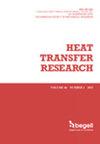石墨烯/C3N 多层平面异质结构热传输特性的分子动力学研究
IF 1.6
4区 工程技术
Q3 THERMODYNAMICS
引用次数: 0
摘要
我们通过非平衡分子动力学模拟研究了石墨烯/C3N多层平面异质结构的界面热导率。结果表明,多层平行堆叠异质结构双层的界面热导率为 12.97 GW/(m2-K),热整流比为 23.80%。多层交错堆叠异质结构的界面热导率和热整流比随着层数的增加而减小,并随着层数的增加而收敛。随着层数的变化,两种堆叠类型的声子参与比也呈现出与界面热导类似的趋势。两种结构的界面热导率都随着温度的升高而大幅提高。多层异质结构的界面热导率可通过改变缺陷类型、浓度和分布比例来调节,声子活动的变化则通过声子态密度和重叠因子 S 来研究。本文章由计算机程序翻译,如有差异,请以英文原文为准。
Molecular dynamics study of the thermal transport properties in the graphene/C3N multilayer in-plane heterostructures
We investigated the interfacial thermal conductance of the graphene/C3N multilayer in-plane heterostructures by non-equilibrium molecular dynamics simulation. The results showed that the interfacial thermal conductance is 12.97 GW/(m2·K) and the thermal rectification ratio is 23.80% in the bilayer of the multilayer parallel stacked heterostructure. The interfacial thermal conductance and the thermal rectification ratio of the multilayer staggered stacked heterostructure decreased with number of the layers increasing and both convergent as the layers. The phonon participation ratio of two stacking types exhibits a similar trend with interfacial thermal conductance as the number of layers changes. The interfacial thermal conductance of both structures were raised substantially with the temperatures. The interfacial thermal conductance of multilayer heterostructures could be adjusted by altering the defect type, concentration, and distribution proportion and the changes in phonon activities were investigated through phonon density of states and overlap factor S. This work proves the reference for thermal management applications in microelectronic devices.
求助全文
通过发布文献求助,成功后即可免费获取论文全文。
去求助
来源期刊

Heat Transfer Research
工程技术-热力学
CiteScore
3.10
自引率
23.50%
发文量
102
审稿时长
13.2 months
期刊介绍:
Heat Transfer Research (ISSN1064-2285) presents archived theoretical, applied, and experimental papers selected globally. Selected papers from technical conference proceedings and academic laboratory reports are also published. Papers are selected and reviewed by a group of expert associate editors, guided by a distinguished advisory board, and represent the best of current work in the field. Heat Transfer Research is published under an exclusive license to Begell House, Inc., in full compliance with the International Copyright Convention. Subjects covered in Heat Transfer Research encompass the entire field of heat transfer and relevant areas of fluid dynamics, including conduction, convection and radiation, phase change phenomena including boiling and solidification, heat exchanger design and testing, heat transfer in nuclear reactors, mass transfer, geothermal heat recovery, multi-scale heat transfer, heat and mass transfer in alternative energy systems, and thermophysical properties of materials.
 求助内容:
求助内容: 应助结果提醒方式:
应助结果提醒方式:


